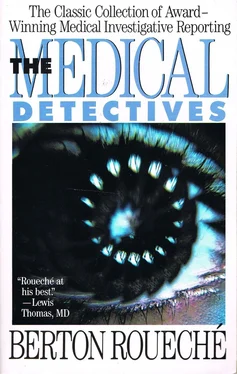The attending physician once more sought out Mr. Tate. He told him what the pathologist had found and what the finding meant. That being the case, he went on to explain, two corollary conclusions were obvious. One was that Mrs. Tate had been attacked and bitten by a rabid animal. The other related to the approximate time of the attack. In view of the usual incubation period of rabies, he felt, it had probably taken place between two and six weeks earlier. The doctor spread his hands. All that remained was to establish the specific source of infection. It could have been a dog. It could have been a cat or a fox. It might even have been a skunk. There were numerous possibilities. Mr. Tate nodded. He appreciated the doctor's position. He doubted, though, if he could be of much help. It depended on what the doctor meant by an animal. His wife had been bitten, all right, and fairly recently, too. On October 9, to be exact. But it wasn't a dog or a cat or any of those. It was a bat. His wife had come across it lying in the road near their house. She had thought it was dead, and stooped down to take a look. The next thing she knew, it had jumped up and given her a nasty nip on the left arm. Then it had flown away.
The doctor hesitated. Very curious, he said. And certainly a most curious coincidence. He shrugged, and rose. But, of course, that was all it could be. The only species of bat in which rabies had ever been demonstrated was the vampire, and its range was limited to tropical Latin America. He was forced to conclude that Mr. Tate was mistaken. There must have been another animal episode. It could have happened as much as a year before. Such cases were uncommon but possible. Either Mr. Tate had forgotten or his wife had neglected to tell him. The doctor returned to his office and took out the record of the case. He dosed it with the notation "Rabies, source unknown."
Officially, the animal responsible for the death of Mrs. Tate is still not known. There is little possibility now that its identity will ever be irrefutably established. The rules of scientific evidence are too rigid for that. Nevertheless, in the opinion of most interested epidemiologists, the case no longer presents much of a riddle. Several subsequent events, they feel, have rendered it to all practical purposes clear. The first of these occurred on a cattle ranch some thirty miles southeast of Tampa, Florida, on June 23,1953. Around ten o'clock that morning, the stockman's son, a boy of seven whom I'll name David Bonner, was playing in the back yard when a bat burst out of a nearby clump of trees. He called to his father, who was at work a short distance away, and pointed. Mr. Bonner glanced up, and stared. It was odd enough to see a bat abroad in the full light of day, but the creature's behavior was even stranger. The bat, when Mr. Bonner first caught sight of it, was circling the house. An instant later, it turned and streaked straight for the woods. Then it was back again—flying high, low, and every which way. Suddenly, from almost directly overhead, it swooped. David screamed, and tried to run. But it was too late. The bat was already upon him. Mr. Bonner crossed the yard in a bound. He caught his son and swung him about. The bat was clinging to the boy's chest, its teeth sunk deep in his flesh, and blood was staining his shirt. Mr. Bonner broke its grip with a backhand swipe. It dropped, with a strangled hiss, to the ground. He gave it a kick, for good measure. Then he picked up his son and carried him into the house.
David was more frightened than hurt. While Mrs. Bonner held and comforted him, his father examined the bite. It was an ugly wound but a small one, and not, Mr. Bonner decided, in any sense serious. There seemed no need to call a doctor. He cleaned the bite with soap and water, dusted it with sulfanilamide, and covered it with a gauze dressing. That—for the moment, at least—appeared to be sufficient. It didn't, however, put his mind altogether at rest.
The circumstances of the assault, he had to admit, were, if nothing else, uncomfortably queer. Mrs. Bonner agreed. They held a hurried conference and reached a prompt decision. Mr. Bonner fetched his jacket and a paper bag, and returned to the back yard. The bat was lying where he had kicked it. Its fur was sandy brown, with yellow overtones, and except for its saucer ears and its long, web-fingered forearms, it might have been a field mouse. It was also, he was relieved to find, dead. He scooped it into the bag, and went on to the garage and his car. Forty minutes later, he was in the Tampa office of the Florida State Board of Health, closeted with a staff epidemiologist.
Mr. Bonner began the interview with a brief account of the incident. He then produced the bat and stated the reason for his visit. He wanted to have the creature examined. It was his understanding, he said, that bats were capable of transmitting rabies. He remembered reading in a livestock journal that they had been linked to an outbreak of the disease among cattle somewhere in South America. That was true, the doctor replied. There had, in fact, been many such cases, and not only among cattle. Several human cases were also on record. Bat rabies, as it was awkwardly called, was endemic in several Latin-American countries. They included Brazil (where the phenomenon was first reported), Honduras, Mexico, Colombia, Venezuela, Surinam, and the island of Trinidad. But, he pointed out, the bats involved were not ordinary bats. They were bats of a kind unknown outside the tropics. They were true, or bloodsucking, vampires. The bat that Mr. Bonner had brought with him was a harmless Florida yellow, a member of the species Dasypterusfloridanus.
It subsisted, like all other bats in the United States, exclusively on insects. Those were the facts. They didn't, of course, explain the attack. He had no theory about that. It was his opinion, though, that the facts held no cause for alarm. The doctor paused. However, he added, it was impossible to deny that the bat had behaved very strangely, and he quite understood how Mr. Bonner felt. A certain amount of uneasiness was only natural. Consequently, in order to settle the matter, he would send the bat along to the board's local laboratory for a routine brain examination. The result, he was confident, would be completely reassuring.
Mr. Bonner left the Board of Health at a little past one. By the time he reached home, it was almost two. At three, he was called to the telephone. It was the epidemiologist in Tampa, and he sounded stunned. He was calling, he said, from the laboratory. A bacteriologist there had just finished a microscopic examination of the bat's brain, and Mr. Bonner, incredibly, was right. The findings were positive for rabies. Arrangements were now being made for the usual confirmatory tests. They involved the inoculation of laboratory mice with bat-brain material, and would be done at the main State Board of Health laboratory, in Jacksonville. But that was largely a formality. The microscopic evidence was in every essential conclusive. Mr. Bonner's son had been bitten by a rabid animal, and it was imperative that preventive measures be taken at once. Could he bring the boy in to the Tampa office that afternoon? Mr. Bonner could, and did. The Pasteur treatment, as the immunizing procedure against rabies is called (in commemoration of its creator), requires a subcutaneous injection of antirabies vaccine every day for two weeks. David completed the course, apparently with success, on July 7, but because of the variable length of the incubation period in rabies, the summer was well over before it could be said that he was in all probability out of danger. That he had been in danger was beyond dispute by then. The Jacksonville tests had confirmed the fact, and so had an even more elaborate investigation, conducted at the request of the Florida authorities by the United States Public Health Service, at its Virus and Rickettsia Laboratory, in Montgomery, Alabama. It was also certain by then that David's experience could not be dismissed as an isolated freak of misfortune. Late in September, while he was still under regular observation, a woman I'll call Frances Roberts suffered an almost identical attack, and that was closely followed by a third. The scene of both was eastern Pennsylvania.
Читать дальше












